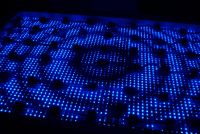Led Matrix: Unterschied zwischen den Versionen
Keine Bearbeitungszusammenfassung |
Benko (Diskussion | Beiträge) Keine Bearbeitungszusammenfassung |
||
| (28 dazwischenliegende Versionen von 10 Benutzern werden nicht angezeigt) | |||
| Zeile 1: | Zeile 1: | ||
For the LED Matrix we | === WTF? === | ||
[[Bild:Matrix_frontside.jpeg|thumb|200px|hypnomatrix is hypnotizing]] | |||
[[Bild:Matrix_backside.jpeg|thumb|200px|all hail to the hypnomatrix]] | |||
For the LED Matrix we wanted to build on the [[CCCamp2007]] we decided to design a GNU LEDMatrix Controller/Driver setup. It consists of two parts the FPGA board and a several driver electronics boards. Now almost one year later we're finally done! | |||
''see also:'' [http://www.flickr.com/photos/1000points/2509802438/ metalab led matrix - demo "die ewigkeit schmerzt"](Video) | |||
== Animations == | |||
Two Animations for the linuxwochen: [[Bild:Metalabanim.zip]] | |||
<div> | |||
<div style='float:left'>{{#ev:youtube|pHdAvMrkO0U}}</div> | |||
</div> | |||
<div style='clear:both'></div> | |||
== Status == | == Status == | ||
We | Everything is soldered and it works. We can stream videos via the parallel interface of the via board to the matrix with 72fps :) | ||
* | |||
* | * main svn: https://whatever.metalab.at/projects/FPGAMatrix/ | ||
* cliffords mplayer patch: http://svn.clifford.at/handicraft/2008/metaleds/ | |||
== Usage examples == | |||
clifford/mplayer/mplayer-bin -vo metaleds:/dev/lp0 -framedrop -vf scale -zoom -x 72 -y 48 test.avi | |||
netcat -l -p 7000 > /dev/lp0 | |||
Format is: 72x48 bytes of pixeldata (ranging from 0x00 to 0x0F) followed by a single 0x80 (to flip framebuffers) | |||
== Real-time access == | |||
=== Raw protocol === | |||
= | 72x48 = 3456 octets of pixel data followed by a terminating 0x80 octet. | ||
Each pixel data octet represents one pixel's brightness, ranging from 0 (0x00, off) to 15 (0x0F, brightest). | |||
The pixels start at the upper left corner and are numbered in [http://en.wikipedia.org/wiki/Row-major_order row-major order] (see the diagram below). | |||
All output is double-buffered on the fpga, so you have to send a 0x80 after the pixel data to flip the frame buffers. | |||
<pre> | |||
________________________ | |||
| 1 2 3 ... 72| | |||
|73 50 ... 144| | |||
|. | | |||
|. | | |||
|... 3456| | |||
|________________________| | |||
</pre> | |||
=== Using with C/C++ === | |||
You can use the metalib library from here; it comes with a couple of demos: | |||
https://whatever.metalab.at/projects/FPGAMatrix/client/ | |||
=== Using with Python === | |||
You can use functions like getpixel, setpixel, submit with the python classes in https://whatever.metalab.at/projects/FPGAMatrix/python/ | |||
It supports the (now encouraged) way of using TCP. A example (Game of Life) is available. | |||
== Specs == | |||
72x48 pixels totals 3456 blue leds | |||
54 column driver modules (current source). | |||
1 row driver mudule (current sink) | |||
The 8 rows are each connected to a powermosfet and are driven to ground one at a time (so the matrix is 8times multiplexed). | The 8 rows are each connected to a powermosfet and are driven to ground one at a time (so the matrix is 8times multiplexed). | ||
For driving the mosfets we use | For driving the mosfets we use two Quad-mosfetdriver which in turn are controlled by a 8bit shifting register. | ||
For the columns we take almost the same components except that we have to source current. The mosfets can source up to 250mA but we limit it to about 20mA. | |||
=== Used ICs === | |||
* [http://www.onsemi.com/PowerSolutions/product.do?id=NID5001N NID5001N] MOSFETS for the row driver | |||
* [http://www.microchip.com/stellent/idcplg?IdcService=SS_GET_PAGE&nodeId=1335&dDocName=en010678 TC4467] used as column driver | |||
* 74HC595 shifting registers | |||
== New MiniITX Board == | |||
VIA EPIA-M 1000G | |||
1 Ghz | |||
1 Gig RAM | |||
MPEG2 Decoderchipset | |||
[[Kategorie:WhateverLab]] | |||
[[Kategorie:Projekte]] | |||
Aktuelle Version vom 19. April 2009, 22:12 Uhr
WTF?


For the LED Matrix we wanted to build on the CCCamp2007 we decided to design a GNU LEDMatrix Controller/Driver setup. It consists of two parts the FPGA board and a several driver electronics boards. Now almost one year later we're finally done!
see also: metalab led matrix - demo "die ewigkeit schmerzt"(Video)
Animations
Two Animations for the linuxwochen: Datei:Metalabanim.zip
Status
Everything is soldered and it works. We can stream videos via the parallel interface of the via board to the matrix with 72fps :)
- main svn: https://whatever.metalab.at/projects/FPGAMatrix/
- cliffords mplayer patch: http://svn.clifford.at/handicraft/2008/metaleds/
Usage examples
clifford/mplayer/mplayer-bin -vo metaleds:/dev/lp0 -framedrop -vf scale -zoom -x 72 -y 48 test.avi netcat -l -p 7000 > /dev/lp0
Format is: 72x48 bytes of pixeldata (ranging from 0x00 to 0x0F) followed by a single 0x80 (to flip framebuffers)
Real-time access
Raw protocol
72x48 = 3456 octets of pixel data followed by a terminating 0x80 octet.
Each pixel data octet represents one pixel's brightness, ranging from 0 (0x00, off) to 15 (0x0F, brightest).
The pixels start at the upper left corner and are numbered in row-major order (see the diagram below).
All output is double-buffered on the fpga, so you have to send a 0x80 after the pixel data to flip the frame buffers.
________________________ | 1 2 3 ... 72| |73 50 ... 144| |. | |. | |... 3456| |________________________|
Using with C/C++
You can use the metalib library from here; it comes with a couple of demos:
https://whatever.metalab.at/projects/FPGAMatrix/client/
Using with Python
You can use functions like getpixel, setpixel, submit with the python classes in https://whatever.metalab.at/projects/FPGAMatrix/python/
It supports the (now encouraged) way of using TCP. A example (Game of Life) is available.
Specs
72x48 pixels totals 3456 blue leds 54 column driver modules (current source). 1 row driver mudule (current sink)
The 8 rows are each connected to a powermosfet and are driven to ground one at a time (so the matrix is 8times multiplexed). For driving the mosfets we use two Quad-mosfetdriver which in turn are controlled by a 8bit shifting register.
For the columns we take almost the same components except that we have to source current. The mosfets can source up to 250mA but we limit it to about 20mA.
Used ICs
New MiniITX Board
VIA EPIA-M 1000G
1 Ghz 1 Gig RAM MPEG2 Decoderchipset